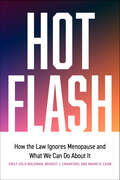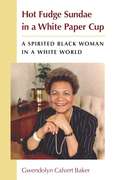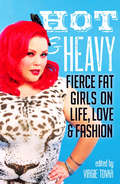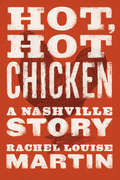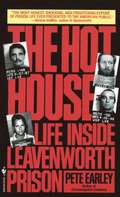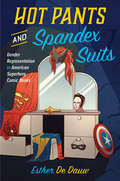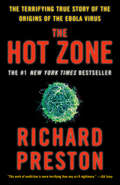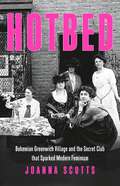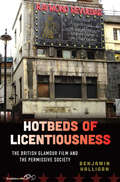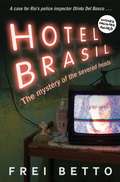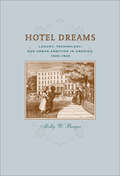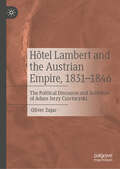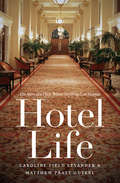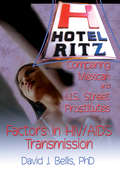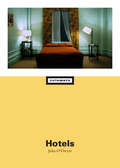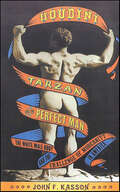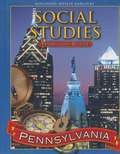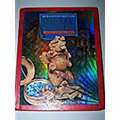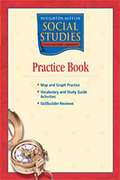- Table View
- List View
Hot Flash: How the Law Ignores Menopause and What We Can Do About It
by Bridget J. Crawford Naomi Cahn Emily Gold WaldmanMore than half the population will experience menopause; it is time for the law to acknowledge it. Menopause is a stage of life that half the population will inevitably experience. But it remains one of the last great taboo topics for discussion, even among close friends and family members. Silence and stigmas around many aspects of reproductive health—from menstruation to infertility to miscarriage to abortion—have historically created the conditions in which bias and discrimination can flourish. Menopause exemplifies that phenomenon, and in Hot Flash, authors Emily Gold Waldman, Bridget Crawford, and Naomi Cahn set out to replace the silence surrounding menopause with a deeper understanding. Hot Flash explores the culturally specific stereotypes that surround menopause as well as how menopause is treated in law and medicine. The book contextualizes menopause as one of several stages in a person's reproductive life. Taking U.S. law regarding pregnancy and breastfeeding as an entry point, the authors suggest changes in existing legislation and workplace policies that would incorporate menopause as well. More broadly, they push us to imagine how law can support a more equitable future. A broader framework further enables the authors to explore menopause discrimination as it is experienced by trans men and gender nonbinary people. They ultimately make the case for a new wave of intersectional feminism that encompasses gender, disability, age, and race.
Hot Fudge Sundae in a White Paper Cup: A Spirited Black Woman in a White World
by Gwendolyn Calvert BakerGwendolyn Calvert Baker has had an extraordinary career and has witnessed a dramatic change in the ways that U.S. schools provide education to and about our multiethnic, multicultural society. But Baker hasn't just lived through the progression of multicultural considerations--she has been singularly instrumental in the creation and acceptance of multicultural education. In Hot Fudge Sundae in a White Paper Cup, she shares her memories and experience of a lifetime spent serving and leading the causes for multicultural education.
Hot & Heavy: Fierce Fat Girls on Life, Love & Fashion
by Virgie TovarIn this fun, fresh, fat-positive anthology, fat activist and sex educator Virgie Tovar brings together voices from an often-marginalized community to talk about and celebrate their lives. Hot & Heavyrejects the idea that being thin is best, instead embracing the many fabulous aspects of being fat-building fat-positive spaces, putting together fat-friendly wardrobes, turning society’s rules into personal politics, and creating supportive, inclusive communities. Writers, activists, performers, and poets-including April Flores, Alysia Angel, Charlotte Cooper, Jessica Judd, Emily Anderson, Genne Murphy, and Tigress Osborn-cover everything from fat go-go dancing to queer dating to urban gardening in their essays, exploring their experiences with the word "fat,” pinpointing particular moments that have impacted the way they think and feel about their bodies, and telling the story of how they each became fat revolutionaries. Ground-breaking and long overdue,Hot & Heavyis a fierce, sassy, thoughtful, authentic, and joyous collection of stories about unapologetically-and unconditionally-loving the body you’re in.
Hot, Hot Chicken: A Nashville Story
by Rachel Louise MartinThese days, hot chicken is a &“must-try&” Southern food. Restaurants in New York, Detroit, Cambridge, and even Australia advertise that they fry their chicken &“Nashville-style.&” Thousands of people attend the Music City Hot Chicken Festival each year. The James Beard Foundation has given Prince&’s Chicken Shack an American Classic Award for inventing the dish. But for almost seventy years, hot chicken was made and sold primarily in Nashville&’s Black neighborhoods—and the story of hot chicken says something powerful about race relations in Nashville, especially as the city tries to figure out what it will be in the future.Hot, Hot Chicken recounts the history of Nashville&’s Black communities through the story of its hot chicken scene from the Civil War, when Nashville became a segregated city, through the tornado that ripped through North Nashville in March 2020.
The Hot House: Life Inside Leavenworth Prison
by Pete EarleyAn explosive eyewitness portrait of life inside the nations' most notorious maximum security prison by the author of "Family of Spies". Earley spent two years inside Leavenworth-- the infamous penitentiary that is home to 1,400 of the nation's most dangerous criminals -- to write this gripping, critically acclaimed investigative report.
Hot Pants and Spandex Suits: Gender Representation in American Superhero Comic Books
by Esther De DauwThe superheroes from DC and Marvel comics are some of the most iconic characters in popular culture today. But how do these figures idealize certain gender roles, body types, sexualities, and racial identities at the expense of others? Hot Pants and Spandex Suits offers a far-reaching look at how masculinity and femininity have been represented in American superhero comics, from the Golden and Silver Ages to the Modern Age. Scholar Esther De Dauw contrasts the bulletproof and musclebound phallic bodies of classic male heroes like Superman, Captain America, and Iron Man with the figures of female counterparts like Wonder Woman and Supergirl, who are drawn as superhumanly flexible and plastic. It also examines the genre’s ambivalent treatment of LGBTQ representation, from the presentation of gay male heroes Wiccan and Hulkling as a model minority couple to the troubling association of Batwoman’s lesbianism with monstrosity. Finally, it explores the intersection between gender and race through case studies of heroes like Luke Cage, Storm, and Ms. Marvel. Hot Pants and Spandex Suits is a fascinating and thought-provoking consideration of what superhero comics teach us about identity, embodiment, and sexuality.
Hot Sauce Nation: America's Burning Obsession
by Denver NicksHot Sauce Nation is a red-hot ride through the story of hot sauce in America. Why should the world's most painful food have inspired such adoration in the USA? While chili pepper-based sauces have transformed cuisines worldwide, successive waves of immigrants landing in the New World have turned up the heat on the American palette with their native pungent sauces. Today, the fast-growing hot sauce industry has made it into everything from salsa to barbecue, buffalo wings, chocolates, and cocktails, inspiring passionate romances and changing people's lives along the way. With fascinating detours into science, history, and current events, as well as stories of the people who make, use, sell, and love hot sauce, this flavorful volume explores the unique hold the condiment has on the American heart.
The Hot Zone: The Terrifying True Story of the Origins of the Ebola Virus (Large Print Bks.)
by Richard PrestonThe bestselling landmark account of the first emergence of the Ebola virus. Now a mini-series drama starring Julianna Margulies, Topher Grace, Liam Cunningham, James D'Arcy, and Noah Emmerich on National Geographic.A highly infectious, deadly virus from the central African rain forest suddenly appears in the suburbs of Washington, D.C. There is no cure. In a few days 90 percent of its victims are dead. A secret military SWAT team of soldiers and scientists is mobilized to stop the outbreak of this exotic "hot" virus. The Hot Zone tells this dramatic story, giving a hair-raising account of the appearance of rare and lethal viruses and their "crashes" into the human race. Shocking, frightening, and impossible to ignore, The Hot Zone proves that truth really is scarier than fiction.
Hotbed: Bohemian Greenwich Village and the Secret Club that Sparked Modern Feminism
by Joanna ScuttsThe dazzling story of the Greenwich Village feminists who blazed the trail for the movement&’s most radical ideasOn a Saturday in New York City in 1912, around the wooden tables of a popular Greenwich Village restaurant, a group of women gathered, all of them convinced that they were going to change the world.It was the first meeting of &“Heterodoxy,&” a secret social club. Its members were passionate advocates of free love, equal marriage, and easier divorce. They were socialites and socialists; reformers and revolutionaries; artists, writers, and scientists. Their club, at the heart of America&’s bohemia, was a springboard for parties, performances, and radical politics. But it was the women&’s extraordinary friendships that made their unconventional lives possible, as they supported each other in pushing for a better world.Hotbed is the never-before-told story of the bold women whose audacious ideas and unruly acts transformed a feminist agenda into a modern way of life.
Hotbeds of Licentiousness: The British Glamour Film and the Permissive Society
by Benjamin HalliganHotbeds of Licentiousness is the first substantial critical engagement with British pornography on film across the 1970s, including the “Summer of Love,” the rise and fall of the Permissive Society, the arrival of Margaret Thatcher, and beyond. By focusing on a series of colorful filmmakers whose work, while omnipresent during the 1970s, now remains critically ignored, author Benjamin Halligan discusses pornography in terms of lifestyle aspirations and opportunities which point to radical changes in British society. In this way, pornography is approached as a crucial optic with which to consider recent cultural and social history.
Hotbeds of Licentiousness: The British Glamour Film and the Permissive Society
by Benjamin HalliganHotbeds of Licentiousness is the first substantial critical engagement with British pornography on film across the 1970s, including the “Summer of Love,” the rise and fall of the Permissive Society, the arrival of Margaret Thatcher, and beyond. By focusing on a series of colorful filmmakers whose work, while omnipresent during the 1970s, now remains critically ignored, author Benjamin Halligan discusses pornography in terms of lifestyle aspirations and opportunities which point to radical changes in British society. In this way, pornography is approached as a crucial optic with which to consider recent cultural and social history.
Hotel Brasil
by Frei Betto Jethro SoutarAccording to the police, the victim was stabbed in the heart before the head was separated from the body. As the investigation continues other hotel clients are decapitated, usually with the head found delicately balanced on the knees of the sitting victim. A witty, touching account of life at the edge of Brazilian society, dressed up as a murder mystery.
Hotel Dreams: Luxury, Technology, and Urban Ambition in America, 1829–1929 (Studies in Industry and Society)
by Molly W. BergerWinner, 2012 Sally Hacker Prize, Society for the History of TechnologyHotel Dreams is a deeply researched and entertaining account of how the hotel's material world of machines and marble integrated into and shaped the society it served. Molly W. Berger offers a compelling history of the American hotel and how it captured the public's imagination as it came to represent the complex—and often contentious—relationship among luxury, economic development, and the ideals of a democratic society.Berger profiles the country's most prestigious hotels, including Boston's 1829 Tremont, San Francisco's world-famous Palace, and Chicago's enormous Stevens. The fascinating stories behind their design, construction, and marketing reveal in rich detail how these buildings became cultural symbols that shaped the urban landscape.
Hôtel Lambert and the Austrian Empire, 1831–1846: The Political Discourse and Activities of Adam Jerzy Czartoryski
by Oliver ZajacThis book analyses the political discourse and activities of the constitutionalist-monarchist wing of the Polish Great Emigration, which saw the emigration of several thousand people from the territory of the former Polish-Lithuanian Commonwealth from 1831 to 1864, after the failure of the November Uprising of 1830–1831. The book examines the political faction of émigrés led by Prince Adam Jerzy Czartoryski, which came to be known as ‘Hôtel Lambert’. By analysing the theoretical discourse in the milieu of the Czartoryski faction and, at the same time, by analysing the plans and efforts to put their theoretical stands into practical policy, the book seeks to answer the question of how the leading representatives of the constitutionalist-monarchist wing of the Great Emigration perceived the Austrian Empire and how their ideas about the past, the present, and the assumption of the future of not only the Polish state but also of the whole of Europe, were projected into their ideas and plans concerning the Austrian Empire. Therefore, the author offers not only conclusions concerning the Austrian Empire from the specific Polish point of view but also interesting perspectives about the projected future of the European continent. Thus, its broad scope provides insights for those researching nineteenth-century European politics, diplomacy, and political thought, particularly regarding phenomena such as nationalism, federalism, democracy, constitutionalism, and perpetual peace theory, among others.
Hotel Life: The Story of a Place Where Anything Can Happen
by Matthew Pratt Guterl Caroline Field LevanderWhat is a hotel? As Caroline Field Levander and Matthew Pratt Guterl show us in this thought-provoking book, even though hotels are everywhere around us, we rarely consider their essential role in our modern existence and how they help frame our sense of who and what we are. They are, in fact, as centrally important as other powerful places like prisons, hospitals, or universities. More than simply structures made of steel, concrete, and glass, hotels are social and political institutions that we invest with overlapping and contradictory meaning. These alluring places uniquely capture the realities of our world, where the lines between public and private, labor and leisure, fortune and failure, desire and despair are regularly blurred. Guiding readers through the story of hotels as places of troublesome possibility, as mazelike physical buildings, as inspirational touchstones for art and literature, and as unsettling, even disturbing, backdrops for the drama of everyday life, Levander and Guterl ensure that we will never think about this seemingly ordinary place in the same way again.
Hotel Ritz - Comparing Mexican and U.S. Street Prostitutes: Factors in HIV/AIDS Transmission
by R Dennis Shelby David J BellisExplore ways to reduce the rate of HIV infection in street prostitutes--and the inescapable connection between the heroin trade, prostitution, and HIV!This unique book draws on face-to-face interviews that the author conducted on the streets, with heroin-addicted street prostitutes in Southern California and their counterparts in four large Mexican cities. Author David James Bellis illustrates the significant--and surprising--differences in the risk of exposure to HIV and other STDs that exist between street prostitutes in the two countries arising from national differences in the legality, sociology, and economics of sex work. He points out that Mexican prostitutes, for whom sex work is a simple means of livelihood, are “choir girls” compared with their beaten-up, drug-addicted sisters north of the border who perform sex for drug money and are at much greater risk of HIV and other diseases, like Hepatitis C. This book explores those differences, suggesting new directions for United States prostitution and heroin-control policies--laws currently so interwoven that they reinforce each other, accounting for a deadly circle of crime and disease. In addition to the fascinating results of the author's interviews with 72 female street prostitutes in San Bernardino, California, and 102 more in Tijuana, Cd. Juárez, Cd. Victória, and Cuernavaca regarding their personal sexual, drug, and health practices, and their criminal histories, Hotel Ritz-Comparing Mexican and U.S. Street Prostitutes: Factors in HIV/AIDS Transmission explores: the licensing process for legal prostitutes in Mexico the medical testing that Mexico requires prostitutes to undergo the differences in what United States and Mexican prostitutes know about HIV transmission the difference in condom use between United States and Mexican prostitutes the potential benefits of reforming prostitution and drug laws in both countries the benefits of making methadone maintenence and syringes-and heroin-free for heroin-addicted prostitutes the proportion of United States/Mexican prostitutes who would quit the trade if they learned they had AIDS how the social support system in the United States (housing subsidies, TANF/AFDC money, food stamps, etc.) leads to a greater proportion of drug-addicted prostitutes than are found in Mexico Hotel Ritz-Comparing Mexican and U.S. Street Prostitutes: Factors in HIV/AIDS Transmission also provides you with a look at the hierarchy of female sex workers, an explanation of the etiology of AIDS transmission, and a concise history of heroin and prostitution. Helpful tables and an appendix containing the author's survey questions make the data in this well-referenced book easily understandable.
Hotels (Cutaways)
by null Jules O'DwyerFrom Marienbad to the Bates Motel, cinematic hotels are more than a mere backdrop to a film’s action. They actively scaffold the formal, aesthetic, and narrative possibilities of cinema. This book takes a journey through spaces of temporary dwelling—hotels, inns, and motels—to delve into the dynamics and contradictions that structure modern life.Along the way, O’Dwyer considers questions of plot and eroticism, labor and globalization, and the ethics and economics of hospitality. Drawing on a broad array of films from European art cinema to experimental adult media, and placing cinema into dialogue with film theory and media history, Hotels explores both how and why the hotel has such a strong purchase on the cinematic imaginary.
Hothouse Kids
by Alissa QuartAlissa Quart's deeply disturbing account looks at the intensely competitive and frenzied lives of America's children. Travelling the country and talking to scores of parents, teachers and children she looks at the overhyped world of baby edutainment and 'better baby' early education programmes, takes the lid off the world of IQ testing and child competitions (from Scrabble and chess to child preaching), and explores the lives of particular children who have been identified as prodigies u from a four-year-old painter whose works sell for $300,000 to an eight-year-old professional skateboarder who is backed by nine corporate sponsors. And she asks the questions that many parents find themselves asking. Where should parents and teachers draw the line? How do we establish when children are being under-stimulated or over-stretched? And can the hothousing of children lead to irreparable problems later in life? Hothouse Kids is a thought-provoking, often shocking exploration of a subject that is only too worryingly topical.
Houdini, Tarzan, and the Perfect Man: The White Male Body and the Challenge of Modernity in America
by John F. KassonA remarkable new work from one of our premier historiansIn his exciting new book, John F. Kasson examines the signs of crisis in American life a century ago, signs that new forces of modernity were affecting men's sense of who and what they really were.When the Prussian-born Eugene Sandow, an international vaudeville star and bodybuilder, toured the United States in the 1890s, Florenz Ziegfeld cannily presented him as the "Perfect Man," representing both an ancient ideal of manhood and a modern commodity extolling self-development and self-fulfillment. Then, when Edgar Rice Burroughs's Tarzan swung down a vine into the public eye in 1912, the fantasy of a perfect white Anglo-Saxon male was taken further, escaping the confines of civilization but reasserting its values, beating his chest and bellowing his triumph to the world. With Harry Houdini, the dream of escape was literally embodied in spectacular performances in which he triumphed over every kind of threat to masculine integrity -- bondage, imprisonment, insanity, and death. Kasson's liberally illustrated and persuasively argued study analyzes the themes linking these figures and places them in their rich historical and cultural context. Concern with the white male body -- with exhibiting it and with the perils to it --reached a climax in World War I, he suggests, and continues with us today.
Houghton Mifflin: My World Poster Book [Kindergarten]
by Ludwig Achim von ArnimNIMAC-sourced textbook
Houghton Mifflin Harcourt Social Studies: Pennsylvania
by Houghton Mifflin Harcourt Publishing Company StaffA Pennsylvania social studies textbook for 4th graders, that takes a step by step approach to learning and practicing key social studies skills.
Houghton Mifflin Social Studies: Western Hemisphere And Europe (Houghton Mifflin Social Studies)
by Houghton Mifflin Company Staff<P>HOUGHTON MIFFLIN <P>SOCIAL STUDIES <P>WESTERN HEMISPHERE & EUROPE <P>GEOGRAPHY AND CULTURE
Houghton Mifflin Social Studies: World Cultures and Geography, Practice Book
by Houghton MifflinNIMAC-sourced textbook
Houghton Mifflin Social Studies Student Edition Supplement Grade 3: World Communities
by Houghton MifflinSocial Studies Student Edition Supplement Grade 3 World Communities
